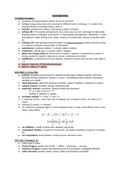BIOCHEM FINAL
THERMODYNAMICS
● exchange of energy between system and its environment
● 1st law: energy conserved, only converted to different forms, U (energy) = 0, system only
change energy by exchange (heat q, work w)
● 2nd law: spontaneous reaction, total energy entropy increases
● entropy (S): # of possible arrangements, how many ways you can rearrange its inside while
keeping outside unchanged, more atoms ⇒ more possible arrangements, distribution ⇒ more
arrangement, higher entropy (vice versa), measure of randomness, change in disorder (delta
S)
● enthalpy (H): heat added/produced by system at constant pressure, reaction absorbs energy
⇒ increases, produces energy (heat) ⇒ decreases
● endothermic: substrate (bottom) ⇒ product, delta H positive
● exothermic: subrate (top) ⇒ product, delta H negative
● gibbs free energy (delta G): driving force of reaction, negative ⇒ spontaneous, positive ⇒
energy needed for reaction, depends on concen. substrate and product,
● equilibrium: no driving force for any direction, forward & reverse occur at same rate, delta G
=0
● delta G = delta G0 - RTln(product/substrate)
● delta G = delta H - T delta S
ENZYMES & CATALYSIS
● enzyme; favorable environments for reactions to take place, catalyse reaction, decrease
activation energy (needed for reaction to occur) ⇒ accelerates rate of reaction, equilibrium
reached more rapidly
● thermodynamics: determine direction of reaction, delta G; stability of substrate vs product
● enzyme kinetics: activation energy, determines rate
● enzymatic reaction; reversible, catalyse forward and backward
○ E + S ⇒ ES ⇒ EP ⇒ E + P
○ binding ⇒ catalysis ⇒ release
● michaelis menten; v = vmax . s / Km + s
● s; substrate concen., vmax; max rate of catalysis, Km; constant (concen. of s where v=½
vmax)
● enzyme (E) concen. ⇒ constant
● Km; affinity for substrate; higher ⇒ more substrate reach ½ vmax, lower affinity, lower ⇒ less
reach, higher affinity
● no inhibition; s binds to active side, allosteric side empty
● competitive inhibitor; compete for binding site, decreased availability of enzyme, increases
Km
● non competitive; binds allosteric, hinder enzyme, decrease Vmax
PROTEIN DYNAMICS (2)
● protein fold ⇒ active
● Central Dogma: genetic info in DNA → mRNA → ribosomes → proteins
● Anfinsen’s Dogma: proteins fold spontaneously and unassisted, investigated RNAseA
● native structure; proteins active, unique, stable and kinetically accessible
, ● Protein Folding: H bonds (secondary structure stabilised), Van Der Waals (compact fold), ion
bond
● equilibrium between unfolded and folded states, which is favoured by interactions above?
FOLDED, H bonds help protein to fold
● is the force entropic or enthalpic? ENTHALPIC, energy released, ΔH
● H bonds; strength, depends on environment, direction & length
● enthalpy; heat released when bond formed, to break interactions
● H bonds exchange H2O ⇒ weak; short + straight bonds ⇒ strongest
● Chain Entropy(T x ΔS): which state has larger multiplicity? UNFOLDED
● which state is entropically more favorable? UNFOLDED
● unfolded; chain adopts may shapes, W >> 1 (multiplicity)
● folded; all same shapes, W = 1, entropy larger
● S = kB x ln x W
○ kB = boltzmann's constant
○ W = multiplicity (number of microscopic states that are identical)
● Disulfide Bond; stabilise protein, 2 cysteine side chains, oxidation reaction (secreted
proteins outside because cytoplasm reducing)
● Stabilise Effect of Disulfide; equilibrium in favour of folding, destabilize unfolded, less
conformations (shapes), makes unfolded state less favorable
● Disulfide Bonds In Insulin (protein hormone); bonds in insulin makes it active hormone
● Hydrophobic Effect: which state has largest contact area with water? UNFOLDED, more
hydrophobic side chains exposed to water? UNFOLDED, favoured by hydrophobic effect?
FOLDED (freeze less water on surface of protein if you fold)
● ΔG = ΔH - (T x ΔS), spontaneous folding: neg ΔG
● fight between entropy (against folding) and enthalpy (favours folding)
● entropy; flexible, dynamic, unfolded favorable than folded
● net stability of protein ⇒ need 2-3 H bonds
● increasing temp ⇒ unfold proteins: Heat increases kinetic energy
● high temperature: reduces stability of proteins, denature (unfold and lose function); 37-28:
can still grow, 40-41: rapid decrease, 42-43: no grow
● lose hydrophobic effect ⇒ protein unfolds, water helps unfolding
● why does acid unfold proteins? all negative charges disappear, protein only contains
positive, repel
● Levinthal’s Paradox; protein folding, small protein, peptide bonds rigid ⇒ no rotation (W),
compact spherical when rotate (a and b sheet), folding is not random, favorable interactions
⇒ stable (guided process)
● to fold ⇒ favorable interactions (H bonds, van der waals, exclude water (hydrophobic
effect) ⇒ fold
● protein folding: cooperative process; at least 4-5 H bonds needed
● secondary structure elements: alpha helix; local interaction, H bonds (i+4), 1 aa’ya 1 aa
duser , zip up (forms) rapidly; antiparallel beta sheet; starts with b hairpin, forms amino acid,
make H bond, zip up; parallel beta sheets; long range H bond forms slowly, amino acid far
apart, align them (costs entropy)
● unfolded: high entropy (S), pos; high free energy (G), pos
● native state (most favorable): low entropy (ΔS negative), gained enthalpy (ΔH negative)
● intermediate state; half folded and half unfolded
● more interactions ⇒ less entropy
● protein folding is enigmatic; not possible to predict 3D structure
● negative ΔH (enthalpy) ⇒ heat released, larger W
● Chaperones; don't fold protein, don’t recognise structure, provide time & space for native
state, prevent aggregation to gain time, actively unfold/misfold, protein folding can fail;
degraded





